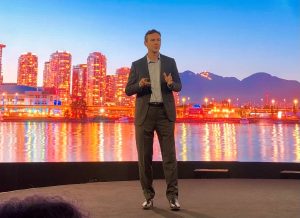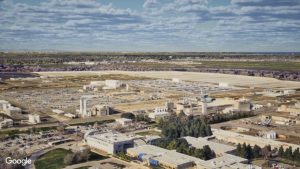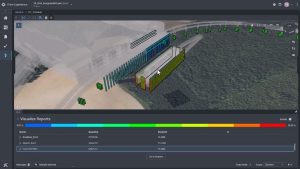“The future of infrastructure engineering is open,” declared Bentley Systems CEO Nicholas Cumins during his keynote address at the Year in Infrastructure 2024 conference, recently held in Vancouver, Canada.
The infrastructure engineering software company, which turned 40 this year, is well known for its much-loved collaboration tool ProjectWise and CAD software MicroStation (used in landmark projects such as the Elizabeth Line in London and the Governor Mario M. Cuomo Bridge in New York).
The family firm founded by five brothers in the mid-1980s, has been savvy enough through innovation, smart acquisitions and the occasional bitter tech battle to ride several tech waves and still come out top as a NASDAQ-listed $1bn company.
But Bentley’s legacy has never hinged on ‘openness.’ Indeed, thanks to its long-standing history with Microsoft, there were traditionally no Mac-native versions of MicroStation or ProjectWise.
This was unusual for a company that makes software for Apple-skewing designers and architects.
But Bentley is entering a new spirit of openness in a post-pandemic world that has become increasingly dependent on interoperable data.
The firm also wants to unlock more of this data, which it intends to do with AI.
Openness
During his keynote, Cumins highlighted the complexity of infrastructure projects, which often involve multiple organisations, teams, and disciplines.
“This complexity makes it impossible for you to rely on any single system or single vendor. Instead, you need an ecosystem that enables flexibility, integration and interoperability across different tools and platforms,” he said.

Nicholas Cumins, Bentley’s new CEO
The Pennsylvania-headquartered firm’s move into digital twins in the early 2020s, with Bentley’s iTwin infrastructure engineering platform, signalled a broader move towards a more open data ecosystem, built on open source, open standards and APIs.
The iTwin has been used worldwide on projects as diverse as railway construction, bridge inspections, and highway management for public transport departments.
Now, following former CEO Greg Bentley’s retirement earlier this year (the last of the brothers to step down), the firm’s former COO Cumins, a dual US-French citizen who is not related to the Bentleys, appears to be leading the charge in this new era of openness.
During his keynote at YII2024, Cumins claimed that the secure data flow was necessary to solve global infrastructure challenges, including expanding energy grids, modernising transportation systems, and retrofitting existing assets to meet sustainable development goals.
He claimed that Bentley has been working on this ecosystem for the last decade, developing a robust, open-source schema specifically for infrastructure.
This framework, he said, goes beyond basic data exchange to ensure that data is not just accessible, but its meaning can also be understood.
“Whether dealing with materials, structures or subsurface data, the schema organises information in a way that enables engineers, constructors and organizations can reuse and fully leverage the value of their data,” he added.
While older versions of MicroStation cannot run on macOS, according to Bentley CTO Julien Moutte, the latest version, MicroStation 2024, can — as well as LINUX.
MicroStation 2024 which is also iTwin enabled, now offers Python scripting capabilities.
During Moutte’s presentation at the event, he also highlighted Bentley’s active contribution to the open-source community for its iTwin product.
Google partnership
The value of open data ecosystems is demonstrated through Bentley’s partnership with Google, one of the many announcements to come out of YII2024 this year.
The partnership integrates Google’s breadth and depth of geospatial data with Bentley’s infrastructure engineering software.
“When this data is combined with Bentley’s infrastructure engineering expertise, the result is an ecosystem where data can flow seamlessly, providing users with access to the most comprehensive and actionable geospatial insights available,” Cumins enthused.
The partnership builds on Bentley’s recent acquisition of 3D geospatial company Cesium, the creator of 3D Tiles.

Example of an open data ecosystem enabled by iTwin, Google 3D tiles and Cesium technology
3D Tiles is an open standard technology used by GoogleMaps, urban planners, architects, and gaming simulators for photorealistic rendering and streaming large 3D datasets.
With this acquisition, Bentley inherits various sitting open-source tenants, including hundreds of contributors, thousands of developers, and millions of end users.
Illustrating a case study of how these technologies all come together to check out things like site suitability, Bentley cited its customer BBV’s ever-morphing infrastructure project HS2, the high-speed railway under construction in the UK.
BBV developed an in-house application to support communities and stakeholders using iTwin, allowing simultaneous streaming of multiple engineering models.
Users could quickly navigate to any asset, generate imagery, and view flythrough videos.
With Cesium, Google 3D Tiles provided geospatial context to aid navigation and enhance the photorealism and depth of the digital twin.
AI: a paradigm shift
The infrastructure sector creates massive amounts of data during design, construction, and operations phases — yet Cumins estimated that only around 10% of it is ever used.
GenAI may help unlock and analyse this data on engineering projects for deep insights, which he hailed as “a paradigm shift.”
To this end, Bentley Systems unveiled OpenSite+, an AI upgrade of the manufacturer’s existing Opensite Designer.
YII2024 guest speaker Joseph Viscuso, from engineering consultancy Pennoni, described how his firm was using the new technology “to do more with less and to do it more accurately.”
Bentley added that the new tool aimed to reduce time and effort in creating, analysing, and optimising site layouts, enabling civil engineers to consider more designs and reduce manual effort.
Bentley and Pennoni’s work on a hotel site near North Carolina Airport was used as a case-in-point to illustrate the bringing together of all these technologies and data.
Data was taken from Google Maps, CAD files, 3D tiles, roadway designs and the company’s own specifications to create a context in a digital twin so that the firm can begin to understand what is already on the site and what would be feasible to build.
Once the designers have ascertained what’s possible via AI, they can use the tools in OpenSite to start designing roadways, parking lots, and buildings and quickly create a design.
Sustainability plus
Bentley Systems also introduced what it hailed as a “game-changing” free new tool for carbon analysis at the company’s annual event.
The tool works within its iTwin Experience platform to analyse where the carbon footprint is the greatest in the whole project so that engineers and designers can address these issues at the design stage.
According to the vendor, the tool aims to streamline calculating embodied carbon, which indicates how much carbon emissions will result from a project’s structures throughout its lifecycle.

Embodied carbon visualization in an airport design
“Using Bentley’s new carbon analysis capabilities helps transform the tedious task of carbon reporting into a smooth, automated process,” said Chris Bradshaw, Bentley’s chief sustainability officer.
Elsewhere, at Bentley’s conference and awards (the YII2024 Awards, considered the “Oscars of Infrastructure design”), Bentley chose to shift the focus from potential construction projects to existing ones.
They highlighted inspection projects that showcased a dedication to brownfield sites and assets, earning praise for their commitment.
Among them was Exo, a finalist and eventual category winner, for its Ohio Falls River Crossing Towers.
Exo used Bentley’s iTwin Capture to process 250 gigabytes of drone footage, which helped determine whether a series of electricity towers needed to be replaced or repaired.
TechInformed will report more about this project and others during our Sustainability-themed week at the end of October.


